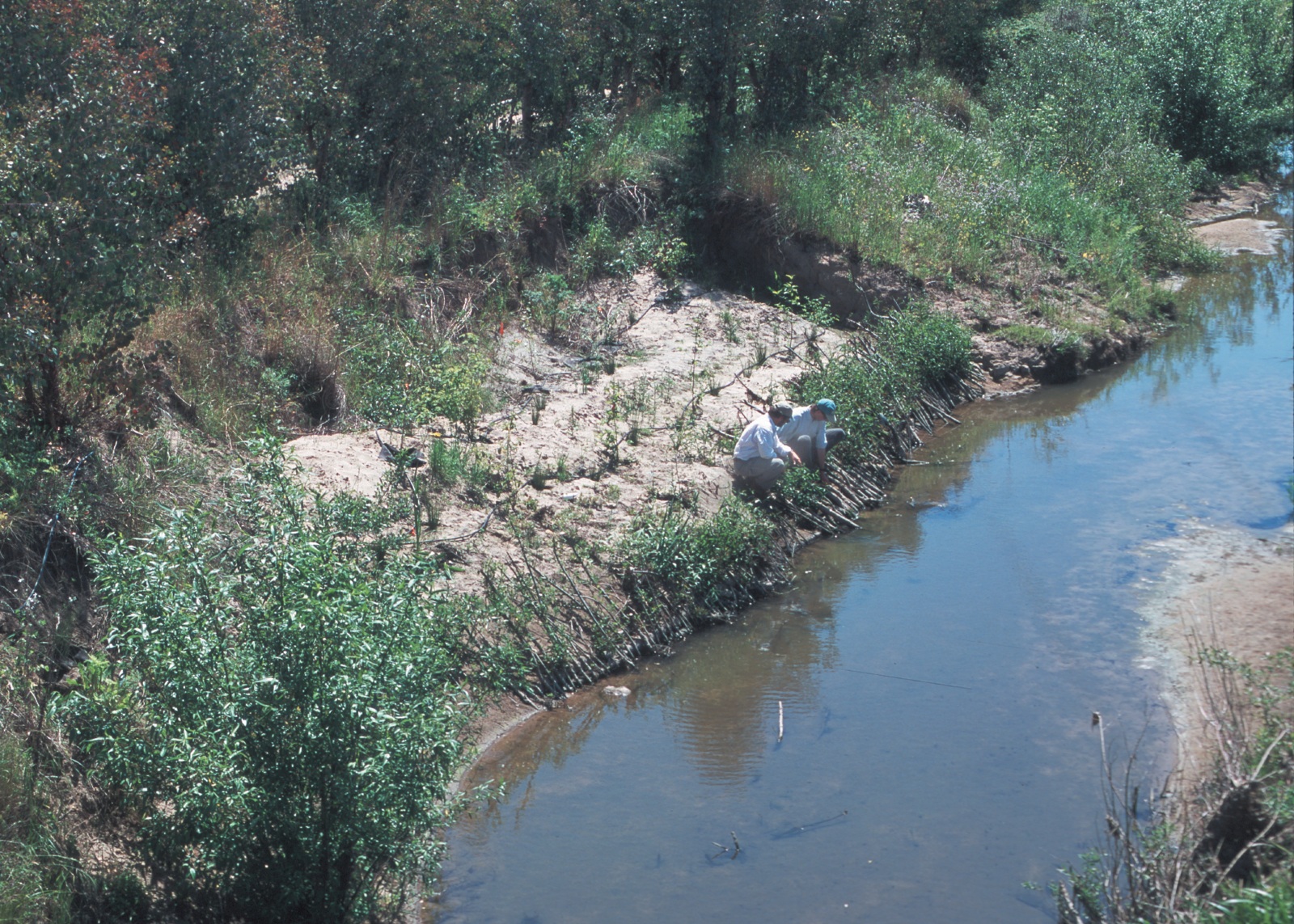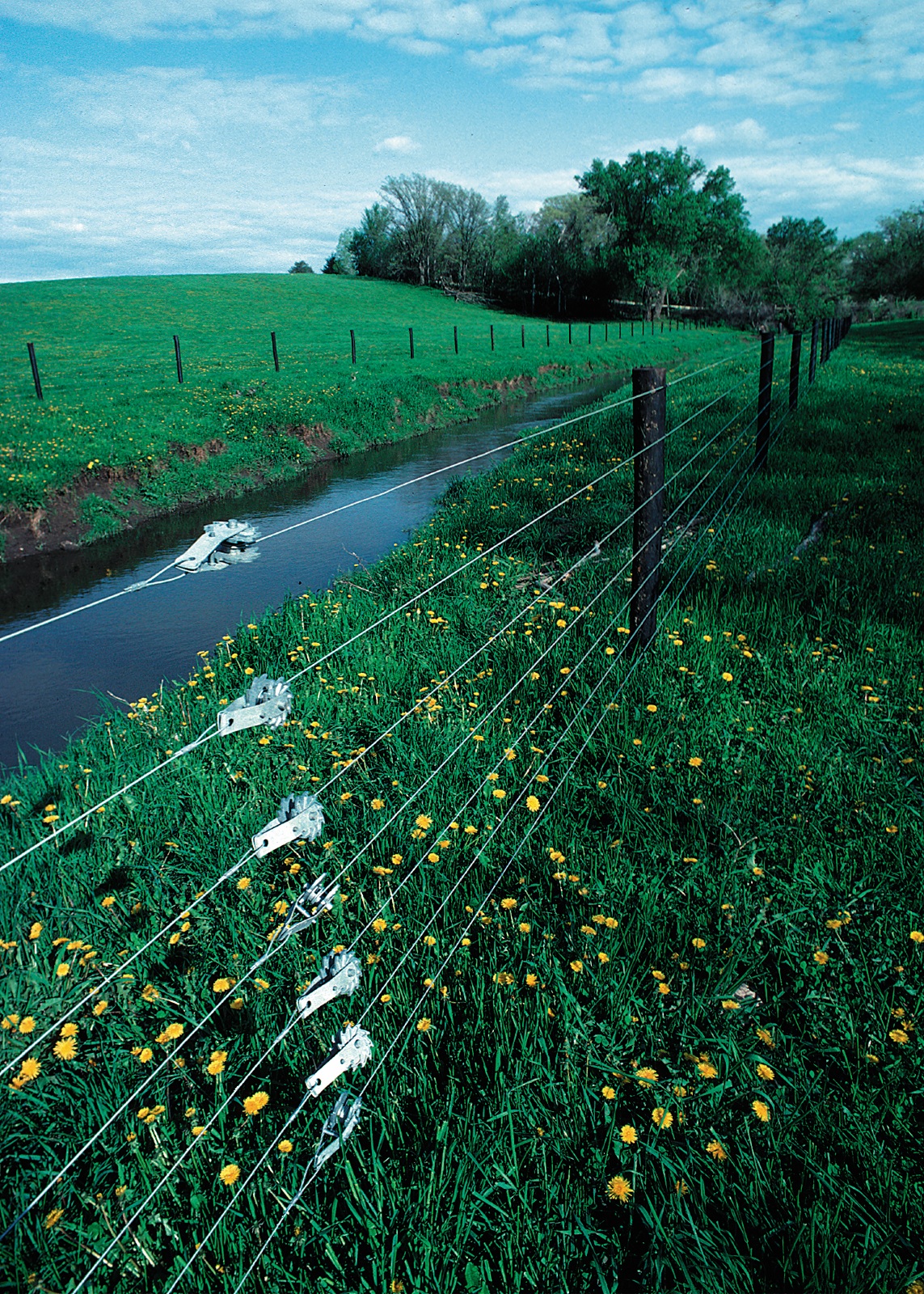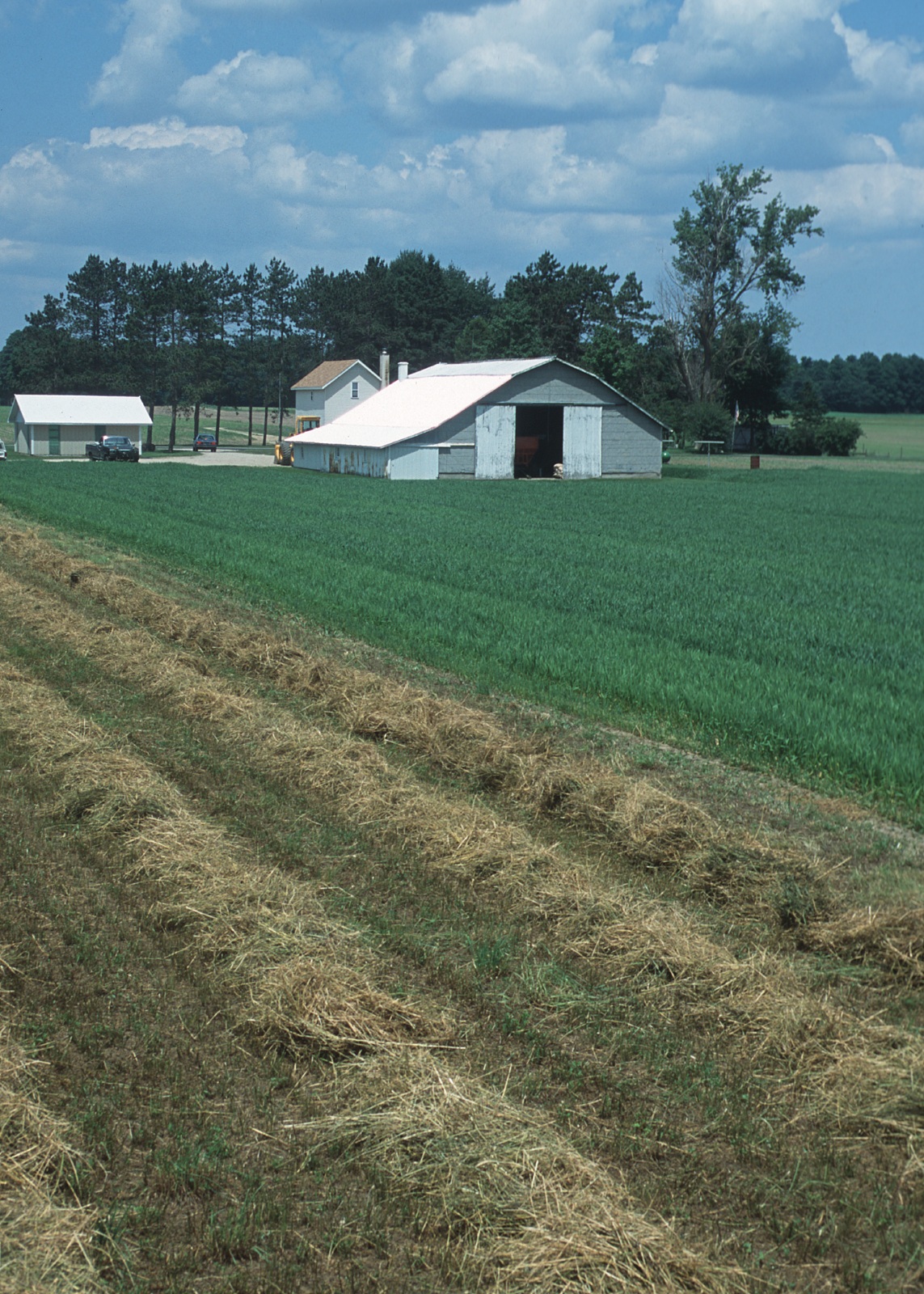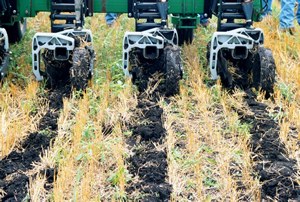-
Download:
My Results |
All BMPs
Stream Restoration
 NRCS employees in Monterey County, CA works on stream restoration project. Photographer: Lynn Betts. Photo Courtsey: USDA NRCS
NRCS employees in Monterey County, CA works on stream restoration project. Photographer: Lynn Betts. Photo Courtsey: USDA NRCS
Practice Type: Structural
Landuse/Agriculture Type: Row Crop, Pasture, Fodder, Rice
Climatic Zones: Temperate, Semiarid, Tropical
Regions: North America, Europe, South America, South Asia, Africa
Pollutants Treated: Nitrogen, Phosphorus, Sediment
Description: Stream restoration is the process of converting unstable, altered and degraded stream corridors, riparian zones and flood plains to natural and stable conditions. Stream restoration can include streambank stabilization, restoring riparian vegetation, meandering of the stream bed, installation of stormwater management facilities, and wetland creation. Stream restoration reduces nutrients by reducing erosion and runoff (through stabilization of the streambank and restoration of riparian zones) in addition to restoring stream nutrient attenuation functions through remeandering of streams.
Implementation Considerations: Stream restoration costs can be substantial, but streambank stabilization can be critical for saving adjacent arable lands.
Scalable to small farms? Yes
Streambank Fencing
 Cattle are fenced off from a stream in northeast Iowa to improve the quality of the water. Photographer: Tim McCabe. Photo Courtsey of USDA NRCS.
Cattle are fenced off from a stream in northeast Iowa to improve the quality of the water. Photographer: Tim McCabe. Photo Courtsey of USDA NRCS.
Practice Type: Structural
Landuse/Agriculture Type: Pasture
Climatic Zones: Temperate, Semiarid, Tropical
Regions: North America, Europe, South America, South Asia, South Africa, Australia
Pollutants Treated: Nitrogen, Phosphorus, Sediment
Description: Streambank fencing is installed along the length of streams or other open water for the purpose of excluding livestock. The area between the fence and the stream is allowed to re-vegetate naturally or might be planted with trees or grass and can be a source of income through agroforestry practices. Streambank fencing provides several benefits. By excluding animals from the stream direct manure deposits from livestock are avoided. The streambank is protected from trampling, reducing streambank erosion and resulting sedimentation. The vegetated area between the fence and the stream functions as a riparian buffer, capturing sediments and cycling nutrients before they reach the stream in addition to providing wildlife habitat. Ideally the fence shoudl be at least 3 meters from the streambank to provide the benefits similar to a riparian buffer. 1
Implementation Considerations: Streambank fencing incurs expenses related to installation and maintenance of the fence, costs of providing alternative water facilities to livestock, and opportunity costs associated with removing a portion of the land from production (i.e. the area between the streambank and the fence). "Live fencing" of suitable vegetation is used in some situations, lowering fencing costs. However, because streambank fencing is a long-term and highly effective practice its overall cost effectiveness for reducing nutrient losses is high.
Scalable to small farms? Yes
1 Estimates of County-level Nitrogen and Phosphorus Data for Use in Modeling Pollutant Reduction Documentation for Scenario Builder Version 2.2." Chesapeake Bay. Dec. 2010. Web. May 2013. http://archive.chesapeakebay.net/pubs/SB_V22_Final_12_31_2010.pdf.
Strip Cropping
 Strip cropping with hay, Grand Traverse County, Michigan. Photographer: Lynn Betts. Photo Courtsey of USDA NRCS.
Strip cropping with hay, Grand Traverse County, Michigan. Photographer: Lynn Betts. Photo Courtsey of USDA NRCS.
Practice Type: Management
Landuse/Agriculture Type: Row Crop, Small Grains, Fodder
Climatic Zones: Temperate, Semiarid, Tropical
Regions: North America, Europe, Africa, Asia
Pollutants Treated: Nitrogen, Phosphorus, Sediment
Description: Strip cropping is the practice of growing alternating, equal-width strips of row crops (such as corn and soybeans in a planned rotation) with strips of close-growing crops (such as forages, small grains or sod). The strips are arranged systematically across a field. In contour strip cropping, crop strips alternate down a slope on the contour (across or perpendicular to the slope) to reduce soil erosion and runoff. This practice helps reduce soil erosion and the transport of sediment and other water- borne contaminants. Contour strip cropping protects growing crops from damage by windborne soil particles and improves water quality. 1
Implementation Considerations: Strip cropping is most effective when grasses and legumes can be rotated with crops requiring more intensive cultivation. This practice will not be effective when land slopes are longer than the critical slope length, unless supported by other practices that reduce slope length below critical (e.g., diversions, terraces).
Scalable to small farms? Yes
1 Carman, Dennis. "Strip Cropping." SERA-17, Minimizing Phosphorus Losses from Agriculture. Web. 1 Jan. 2014. http://www.sera17.ext.vt.edu/Documents/BMP_strip_cropping.pdf .
Strip Tillage (Conservation Tillage)
Category: Erosion Control
Practice Type: Management
Landuse/Agriculture Type: Row Crop
Climatic Zones: Temperate, Semiarid, Tropical
Regions: North America, Europe
Pollutants Treated: Nitrogen, Phosphorus, Sediment
Description: Strip tillage is a form of conservation tillage where the field is tilled in narrow strips, leaving the rest of the field undisturbed. Crops are planted into the narrow tilled strips. Strip till provides a better seed bed than no-till. If liquid fertilizer is being applied it can be applied directly to the seed row, improving the proximity of fertilizer to the roots, reducing the amount of fertilizer needed. Strip till has a somewhat greater risk of erosion as compared to a no-till system. Strip tillage provides excellent erosion control and soil moisture conservation. And builds soil structure and health.1
Implementation Considerations: The clean strips are more erodible than soil that is covered with residue; contour farming may be necessary. Special equipment is needed to provide the clean strips. Because of the special equipment required, strip-till planting may be more expensive to use than other conservation tillage types. Soil moisture requirement at planting time may be more critical, and soil structure may be damaged by improper operation of rotary strip-till planters.
Scalable to small farms? Yes
Scaling Considerations: See box 5 in this FAO publication for examples from southern Brazil.http://www.fao.org/docrep/003/y1730e/y1730e03.htm
1 "Best Management Practices, Today's Agriculture: A Responsible Legacy." Nutrient Best Management Practices. Web. Aug. 2013. http://dda.delaware.gov/nutrients/D17762BestMgmtbklt.pdf .
Practice Type: Management
Landuse/Agriculture Type: Row Crop
Climatic Zones: Temperate, Semiarid, Tropical
Regions: North America, Europe
Pollutants Treated: Nitrogen, Phosphorus, Sediment
Description: Strip tillage is a form of conservation tillage where the field is tilled in narrow strips, leaving the rest of the field undisturbed. Crops are planted into the narrow tilled strips. Strip till provides a better seed bed than no-till. If liquid fertilizer is being applied it can be applied directly to the seed row, improving the proximity of fertilizer to the roots, reducing the amount of fertilizer needed. Strip till has a somewhat greater risk of erosion as compared to a no-till system. Strip tillage provides excellent erosion control and soil moisture conservation. And builds soil structure and health.1
Implementation Considerations: The clean strips are more erodible than soil that is covered with residue; contour farming may be necessary. Special equipment is needed to provide the clean strips. Because of the special equipment required, strip-till planting may be more expensive to use than other conservation tillage types. Soil moisture requirement at planting time may be more critical, and soil structure may be damaged by improper operation of rotary strip-till planters.
Scalable to small farms? Yes
Scaling Considerations: See box 5 in this FAO publication for examples from southern Brazil.http://www.fao.org/docrep/003/y1730e/y1730e03.htm
1 "Best Management Practices, Today's Agriculture: A Responsible Legacy." Nutrient Best Management Practices. Web. Aug. 2013. http://dda.delaware.gov/nutrients/D17762BestMgmtbklt.pdf .
Structural Shoreline Control
 Shore Protection against coastal erosion in Kumta, Karnataka, India. Photo courtesy Anurag Tamhankar
Shore Protection against coastal erosion in Kumta, Karnataka, India. Photo courtesy Anurag Tamhankar
Practice Type: Structural
Climatic Zones: Temperate
Regions: North America
Pollutants Treated: Nitrogen, Phosphorus, Sediment
Description: Structural tidal shoreline erosion control is designed to protect eroding shorelines. These practices are rigid, barrier-type structures that result in hardening of the shoreline to protect against the action of waves, currents, tides, wind driven water, runoff storms, or groundwater seepage that erodes shorelines. 1
Implementation Considerations: Establishing shoreline protection wetlands requires the use of land along the shoreline.
Scalable to small farms? No
1 Estimates of County-level Nitrogen and Phosphorus Data for Use in Modeling Pollutant Reduction Documentation for Scenario Builder Version 2.2." Chesapeake Bay. Dec. 2010. Web. May 2013. http://archive.chesapeakebay.net/pubs/SB_V22_Final_12_31_2010.pdf.
